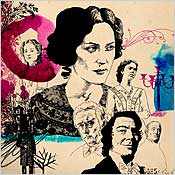
You will want to know about Gillian Anderson, who plays Lady Dedlock in the eight-hour Masterpiece Theatre production of the Charles Dickens lawyer novel. How has her passage gone, from the FBI and aliens on The X Files to extortion and murder in Victorian England? Well, she is asked to be beautiful and to suffer, and so she is and does, like a Ming vase with a Munch scream.
She also seems to speak more slowly than anyone else in the nineteenth century, as if editing to subtract fripperies, add ellipses, and interrogate herself, whether all she ends up saying is that “I … am … perfectly … well” or what she needs to communicate is rather more fraught: “I am … your mother … your wretched and unhappy … mother.” Otherwise, it’s difficult to determine what she does to pass the day in her country house with Sir Leicester (Timothy West), her doting muttonchop of a husband.
But Lady Dedlock is only one of several suspects in the murder of Mr. Tulkinghorn (Charles Dance), a barrister whose machinations in the contested-wills case of Jarndyce v. Jarndyce are so obscene that I wanted to shoot him myself. Nor is Lady D. a smidgen as plucky or heroic as the daughter she believes to be dead, the daughter who has grown up thinking she is an orphan, the daughter whose face may be disfigured from smallpox but whose deep-pore soul is radiant. Esther Summerson (Anna Maxwell Martin) is such a super–Goody Two-shoes—always there to brush the hair of Ada Clare (Carey Mulligan); so grateful to Ada’s guardian, John Jarndyce (Denis Lawson), for hiring her as Ada’s companion that she has agreed to marry him; smallpoxed in the first place because she insisted on nursing a sick slum child—that Dickens either has to reward her richly or kill her off. He kills off her mother instead.
Or am I telling you too much? Is anybody who hasn’t read Bleak House likely to watch an eight-hour television production, even one as loving as this is, with its Andrew Davies (Pride & Prejudice) screenplay? As in earlier British-TV extravaganzas, such as the six-hour version of Our Mutual Friend in 1999 and the thirteen-hour mini-series of Paul Scott’s The Jewel in the Crown, talented British actors threw themselves into this project. Of course, we expect Ian Richardson, as the insouciant Lord Chancellor, to enjoy wasting everybody else’s time and money; and Nathaniel Parker’s taking time off from The Inspector Lynley Mysteries to play Skimpole as a feckless wart; and Pauline Collins, still vivid from Upstairs, Downstairs, to embody Miss Flite perfectly, letting the songbirds out of their cages. But even the bit parts, the odd grotesqueries, are equally inhabited by strong personalities pleased to be asked to the party: Philip Davis as the loathsome moneylender Smallweed, Johnny Vegas as the gin-stinking junk man Krook, Alun Armstrong as the slobbery but honorable Detective Bucket. And Burn Gorman is a terrific Guppy, the law clerk who loves above his station. All this, plus as much plot as the Mahabharata.
Some years ago, David Lodge wrote a novel called Nice Work in which a Marxist-feminist observed that no matter how bad nineteenth-century English novelists felt about the dark satanic mills, it never occurred to them that there was any other solution to a social problem except fortuitous marriage, miraculous inheritance, sudden death, or immigration to Australia. And nobody felt worse than Dickens, the boy whose mother didn’t love him enough and whose father went to debtors’ prison, the teenager who emerged from a blacking factory determined, like David Copperfield, to become “the hero of my own life,” the troublemaker whose inquiries into child labor, workhouse conditions, prostitution, and a corrupt judiciary inspired more social reform than did the Chartists or the Fabians. And yet no writer leaned more on lucky coincidence to get him out of a narrative jam. All that’s missing from Bleak House is Australia.
Instead, we get bonnets, wigs, rope, bricks, swords, pianos, and a morgue, as well as blackmail, suicide, embezzlement, kidnapping, and murder, not to mention tuberculosis, opium addiction, spontaneous combustion, and splendid television. How could it not be splendid television? I have said before that Dickens and television were made for each other. Both are vital, promiscuous, disorderly, and surreal; both are theatrical, even stagy; both traffic in stereotypes and specialize in abused children, inadequate parents, and oppressive institutions; and both can be counted on, between murders, to express compassion for the underdog in gothic sentimentality or in fairy tales dressed up as social realism. And both seek, when not trolling for belly laughs, to balance the skewed accounts of the world with rough justice, and maybe mercy, or at least revenge.

In playing Lady Dedlock, ex-X Filer Gillian Anderson keeps her career pleasantly paralleled with ex-Avenger Diana Rigg. Both women played sexy operatives before finding their dignity in writers of yore (Edith Wharton’s The House of Mirth for Anderson, Shakespeare for Rigg). And Rigg also played the doomed Lady Dedlock, in a 1985 Bleak House TV mini-series. Rigg’s career has also included a few Tonys, a dame-hood, and a part in The Great Muppet Caper. Anderson’s won an Emmy and earned accolades for her stage work on London’s West End. So all she needs now is a starring role opposite Kermit the Frog.
Bleak House
PBS. Sundays, 9 p.m.
Premieres January 22.